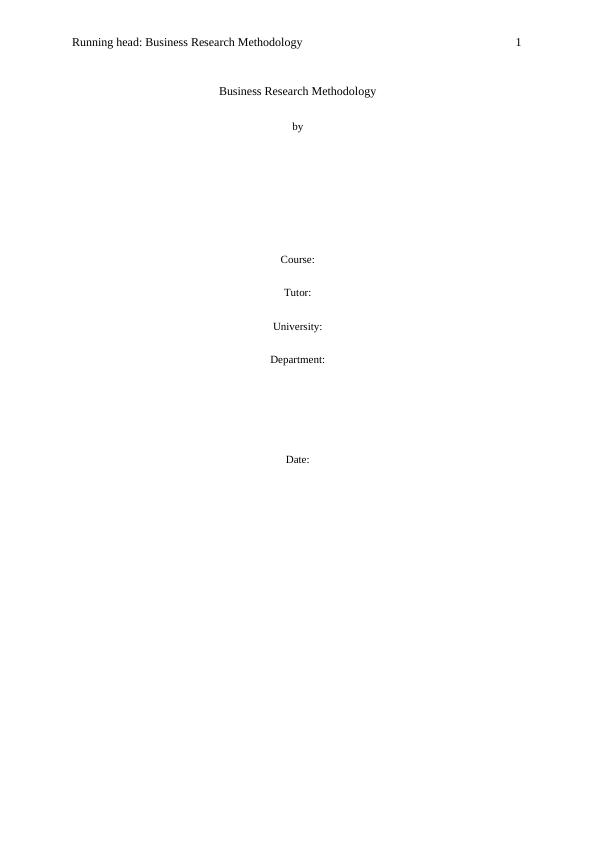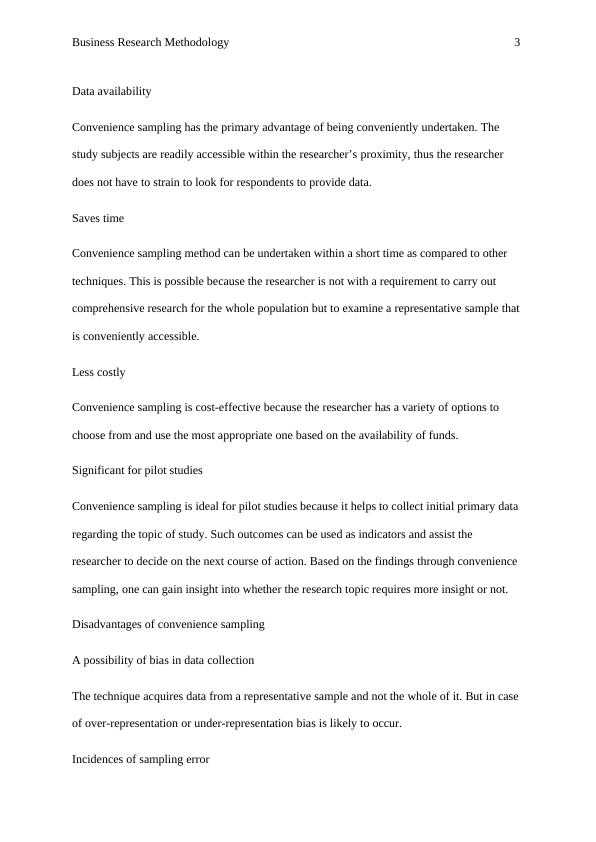Business Research Methodology
Added on 2023-04-06
6 Pages893 Words274 Views
Running head: Business Research Methodology 1
Business Research Methodology
by
Course:
Tutor:
University:
Department:
Date:
Business Research Methodology
by
Course:
Tutor:
University:
Department:
Date:

Business Research Methodology 2
Question 1
Stratified random sampling is an approach in which the population is divided into various
homogenous divisions referred to as ‘strata’, and the sample is randomly selected from each
stratum. Cluster sampling is an approach in which the population units are chosen in a
random manner from thro the already existing groups referred to as ‘cluster’ (Acharya,
Prakash, Saxena, & Nigam, 2013).
There is a random selection of individuals from all strata, in stratified random sampling, in
order to come up with the sample. Conversely, in cluster sampling, a sample is constituted
once all the individuals are selected from the chosen clusters and in a random manner.
Population units are chosen in aggregates in the case of cluster sampling, but in stratified
sampling, the elements of the population are singly chosen from each stratum.
Homogeneity exists between groups in cluster sampling, whereas homogeneity is present
within the group in the case of stratified sampling. In stratified sampling, heterogeneity exists
between groups, however, in the case of cluster sampling, the individuals in the group are
heterogeneous.
Sampling error can be minimized in stratified sampling by minimizing the differences within
groups among the strata while maximizing the differences between the groups among the
strata. On the other hand, the sampling error in cluster sampling can be minimized by
ensuring that the variations between the group are consistent with those in the population, and
the differences between the groups among the clusters are maximized (Singh & Masuku,
2014).
Question 2
Advantages of Convenience sampling
Question 1
Stratified random sampling is an approach in which the population is divided into various
homogenous divisions referred to as ‘strata’, and the sample is randomly selected from each
stratum. Cluster sampling is an approach in which the population units are chosen in a
random manner from thro the already existing groups referred to as ‘cluster’ (Acharya,
Prakash, Saxena, & Nigam, 2013).
There is a random selection of individuals from all strata, in stratified random sampling, in
order to come up with the sample. Conversely, in cluster sampling, a sample is constituted
once all the individuals are selected from the chosen clusters and in a random manner.
Population units are chosen in aggregates in the case of cluster sampling, but in stratified
sampling, the elements of the population are singly chosen from each stratum.
Homogeneity exists between groups in cluster sampling, whereas homogeneity is present
within the group in the case of stratified sampling. In stratified sampling, heterogeneity exists
between groups, however, in the case of cluster sampling, the individuals in the group are
heterogeneous.
Sampling error can be minimized in stratified sampling by minimizing the differences within
groups among the strata while maximizing the differences between the groups among the
strata. On the other hand, the sampling error in cluster sampling can be minimized by
ensuring that the variations between the group are consistent with those in the population, and
the differences between the groups among the clusters are maximized (Singh & Masuku,
2014).
Question 2
Advantages of Convenience sampling

Business Research Methodology 3
Data availability
Convenience sampling has the primary advantage of being conveniently undertaken. The
study subjects are readily accessible within the researcher’s proximity, thus the researcher
does not have to strain to look for respondents to provide data.
Saves time
Convenience sampling method can be undertaken within a short time as compared to other
techniques. This is possible because the researcher is not with a requirement to carry out
comprehensive research for the whole population but to examine a representative sample that
is conveniently accessible.
Less costly
Convenience sampling is cost-effective because the researcher has a variety of options to
choose from and use the most appropriate one based on the availability of funds.
Significant for pilot studies
Convenience sampling is ideal for pilot studies because it helps to collect initial primary data
regarding the topic of study. Such outcomes can be used as indicators and assist the
researcher to decide on the next course of action. Based on the findings through convenience
sampling, one can gain insight into whether the research topic requires more insight or not.
Disadvantages of convenience sampling
A possibility of bias in data collection
The technique acquires data from a representative sample and not the whole of it. But in case
of over-representation or under-representation bias is likely to occur.
Incidences of sampling error
Data availability
Convenience sampling has the primary advantage of being conveniently undertaken. The
study subjects are readily accessible within the researcher’s proximity, thus the researcher
does not have to strain to look for respondents to provide data.
Saves time
Convenience sampling method can be undertaken within a short time as compared to other
techniques. This is possible because the researcher is not with a requirement to carry out
comprehensive research for the whole population but to examine a representative sample that
is conveniently accessible.
Less costly
Convenience sampling is cost-effective because the researcher has a variety of options to
choose from and use the most appropriate one based on the availability of funds.
Significant for pilot studies
Convenience sampling is ideal for pilot studies because it helps to collect initial primary data
regarding the topic of study. Such outcomes can be used as indicators and assist the
researcher to decide on the next course of action. Based on the findings through convenience
sampling, one can gain insight into whether the research topic requires more insight or not.
Disadvantages of convenience sampling
A possibility of bias in data collection
The technique acquires data from a representative sample and not the whole of it. But in case
of over-representation or under-representation bias is likely to occur.
Incidences of sampling error

End of preview
Want to access all the pages? Upload your documents or become a member.
Related Documents
Assignment on Sampling and G Power Analysislg...
|11
|2421
|21
MDM4U Evaluating Research Assignmentlg...
|4
|1530
|58
Evaluating Sampling Methods and Sample Size | Caseslg...
|13
|3099
|16
Introduction to Statistics Assignmentlg...
|5
|921
|338
Sampling, Hypothesis Testing, and Regressionlg...
|8
|1706
|608
Sampling, Hypothesis Testing, and Regressionlg...
|8
|1706
|278
